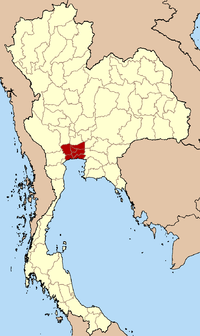Bangkok Metropolitan Region

The Bangkok Metropolitan Region (Thai: กรุงเทพมหานครและปริมณฑล; RTGS: Krung Thep Mahanakhon Lae Parimonthon; Literally: Bangkok and surrounding provinces), may refer to a government defined political definition of the urban region surrounding Bangkok Metropolis, or the built-up area i.e. urban agglomeration of Bangkok, Thailand, which varies in size and shape, and gets filled in as development expands.
The political definition is defined as the metropolis and the entire 5 adjacent provinces of Nakhon Pathom, Pathum Thani, Nonthaburi, Samut Prakan and Samut Sakhon.
Area and population
The Bangkok Metropolitan Region (political definition) covers an area of 7,761.50 km².[1]
Due to the success of the service and tourism industry in Bangkok, the city has gained in popularity for work among provincial Thais from the rural areas and with people from many countries in the Indochina region as well as many South Asian countries. In the past 20–30 years, there has been a large influx of Indians, Pakistanis, Persians, Burmese, Cambodians, Laotians, Indonesians,Nepalis, Filipinos, Chinese and others emigrating to Thailand as well as Bangkok. There are large numbers of workers who legally reside outside the metropolitan area and travel into the city for day jobs. The population of Bangkok Metropolis ("the city") increases to 9 million during the day, from 8 million, however the morning influx into the Greater Metropolitan Region is not very significant, rather the influx is seasonal depending upon crop seasons in the rest of the country.
However, during New Year's break, Songkran break and other long weekends, the capital often seems deserted of many taxi drivers, side street vendors and other forms of informal services many illegal residents engage in.
Urban build-up
Bangkok has seen rapidly urbanization since its population hit 2 million in the 1960s. Since the 1980s, Greater Bangkok's built-up areas have spilled beyond Bangkok Metropolis' borders to neighboring provinces, initially to the north and south. Despite a general suburbanization trend, Bangkok remained centralized and the city core remained extremely dense until the early 2000s as crushing commuter traffic limited choices. The countryside between once independent towns and the capital became ever more filled in, with the advent and expansion of urban rail transit, as well as cheap credit enabling automobile adoption amongst the working class, the outward push of suburbanization has intensified as park and ride lots near train termini have sprung up.
In a manner similar to Los Angeles, Bangkok is transforming into a region where traffic flows in all directions rather than simply to the central core, as it once did. Suburbanziation has swallowed ever more fields and swamps, though even parts of Bangkok province itself are not built-up. The first areas to suburbanize were in Pathum Thani, Nonthaburi, and Samut Prakan provinces. Additional areas more recently have agglomerated in Samut Sakhon and Nakhon Pathom. Samut Prakan, Nonthaburi, Pathum Thani and Samut Sakhon all have a historic city center.
Due to lacking of strict zoning laws, the Metropolitan areas' growth looks rather random and everywhere. Central areas like Yaowarat, Siam, Sukhumvit and Sathorn have seen skyrocketing land speculation as foreign investors are allowed to own condominiums, giving rise to a Manhattanization. At the same time, fringe areas are being developed and the boundaries are no longer visible between each province the historic city centers. Due to the speed of this urban sprawl over the past twenty years, the Bangkok Metropolitan Administration has sought to tackle rising problems of commute times, pollution and deteriorating air quality. Recent administrations have been relatively successful in conserving the air quality, however the city still lacks an effective mass transit network and a clean and resolving plan on implementing environmental practices. This form of urbanization is not only limited to Bangkok but traces can be found in metropolitan areas where there has been a quick surge in population. The Pattaya-Chonburi Metropolitan Area is a prime example due to the increase in residential high rise living and the rush for commercial office space. The shared infrastructure of Greater Bangkok and Greater Pattaya-Chon Buri, being physically close, helps fuel the latter's torrid development.
Population Table
| Administrative Area | Area km² |
Population (2000Cf) |
Population (2010Cp) |
Population (2011 Registered) |
Population (Sep, 2013 Registered) |
Pop.Density Inh/km²(2010C) |
|---|---|---|---|---|---|---|
| Bangkok Metropolis | 1,568.737 | 6,355,144 | 8,249,117 | 5,674,843 | 5,683,686 | 5,258.6 |
| Nonthaburi | 622.30 | 816,614 | 1,333,623 | 1,122,627 | 1,152,401 | 2,143.1 |
| Samut Prakan | 1,004.50 | 1,028,401 | 1,828,044 | 1,223,302 | 1,237,047 | 1,820.6 |
| Pathum Thani | 1,525.90 | 677,649 | 1,326,617 | 1,010,898 | 1,048,665 | 869.4 |
| Samut Sakhon | 872.30 | 466,281 | 885,559 | 499,098 | 516,392 | 1015.2 |
| Nakhon Pathom | 2,168.30 | 815,122 | 942,560 | 866,064 | 880,716 | 434.7 |
| Greater Bangkok | 7,762.00 | 10,159,211 | 14,565,520 | 10,396,832 | 10,518,907 | 1,876.64 |
source: http://www.citypopulation.de/php/thailand-admin.php (on NSO.go.th Census Data, 2010 figures subject to revision.)
| ||||||
Traffic
As of October 31, 2012, some 7,384,934 vehicles were registered in the metro area, roughly 1 vehicle for every two people.[8] To alleviate this congestion, massive railway development is ongoing, but its construction is causing large scale disturbance to major thoroughfares, the Bangkokian love affair with cars is causing high levels of air pollution and large oil import bills.
Green Lung
Bangkok's last undisturbed forested zone, in Phra Pradaeng, also known as "the Green Lung" or "Pig's Stomach" (rtgs: krapho mu) is under threat of development as of 2014.
See also
Resources
References
- ↑ http://www.citypopulation.de/Thailand.html
- ↑ http://www.economist.com/news/asia/21572800-long-standing-worker-abuses-get-some-serious-attention-deadly-cocktail
- ↑ http://eeas.europa.eu/delegations/thailand/documents/thailande_eu_coop/migration_management/3_4current_migration_challenges_in_thailand_en.pdf
- ↑ http://stat.bora.dopa.go.th/stat/y_stat54.html
- ↑ http://www.lexology.com/library/detail.aspx?g=9c9cc033-62ac-4a2a-b4cb-77db75c1b9a0
- ↑ http://www.nationmultimedia.com/national/Junta-No-crackdown-on-foreign-workers-30236412.html
- ↑ http://www.bangkokpost.com/news/local/415847/thailand-cambodia-to-quash-rumours-after-worker-exodus
- ↑ http://www.nationmultimedia.com/national/Traffic-in-Bangkok-set-to-worsen-in-2014-official--30196243.html